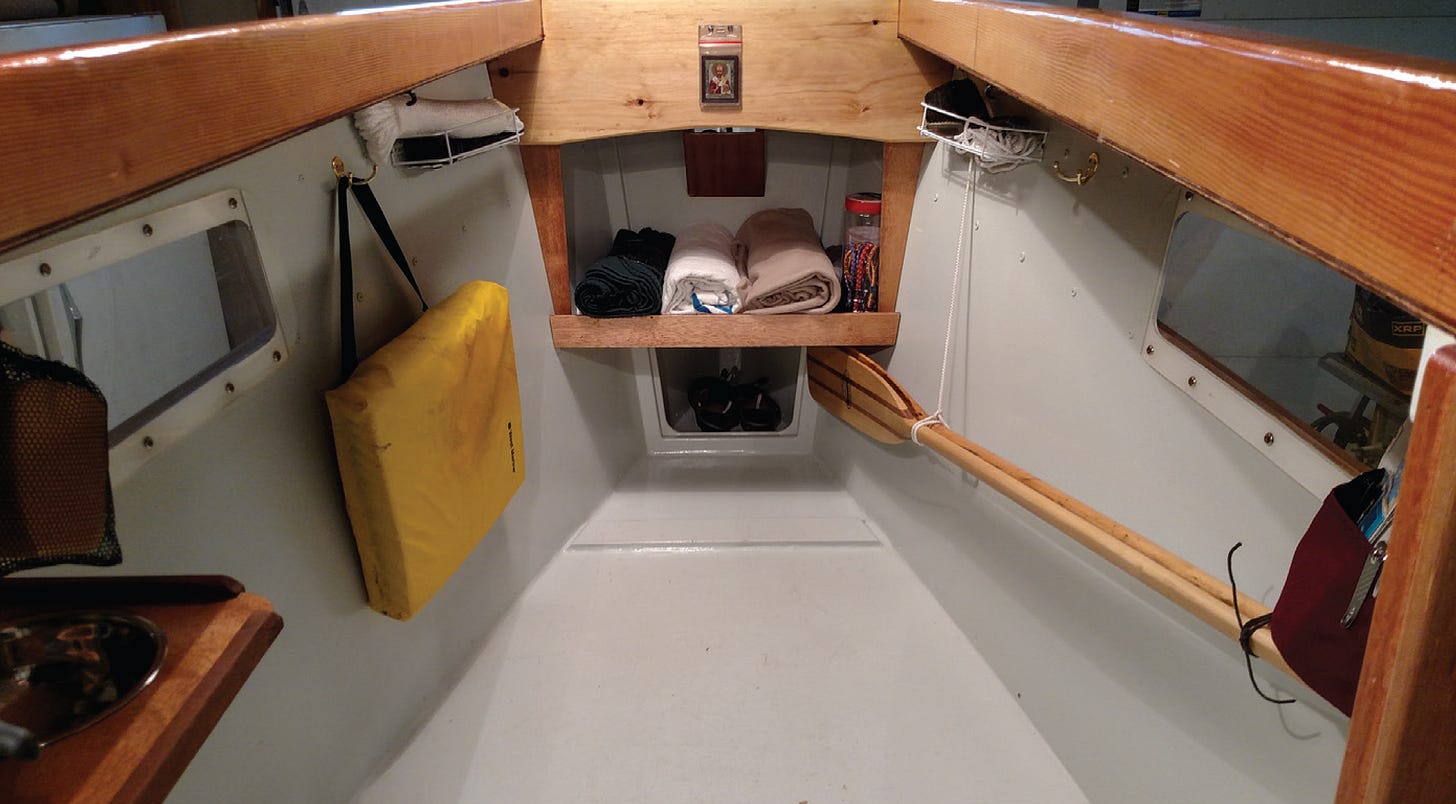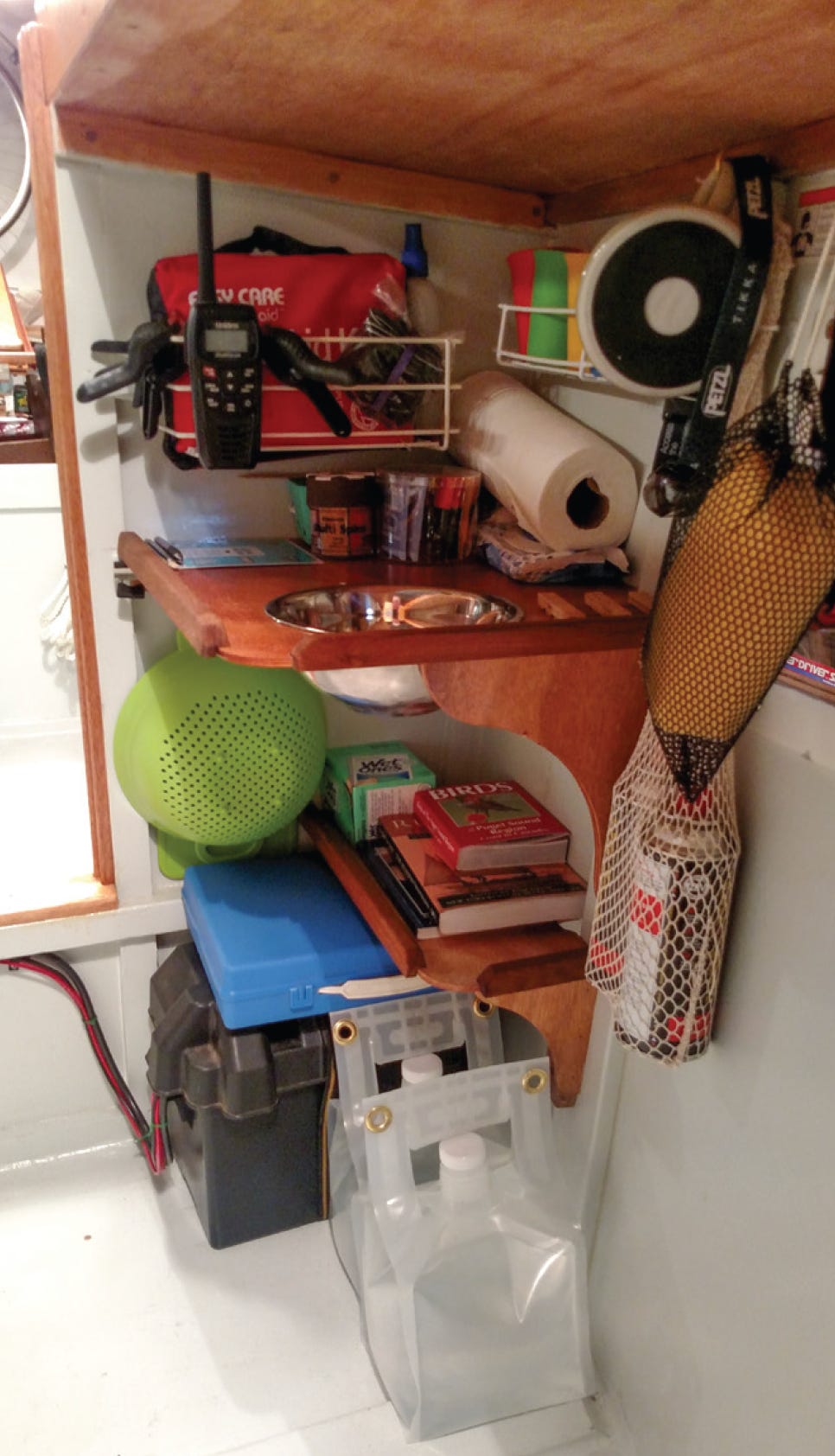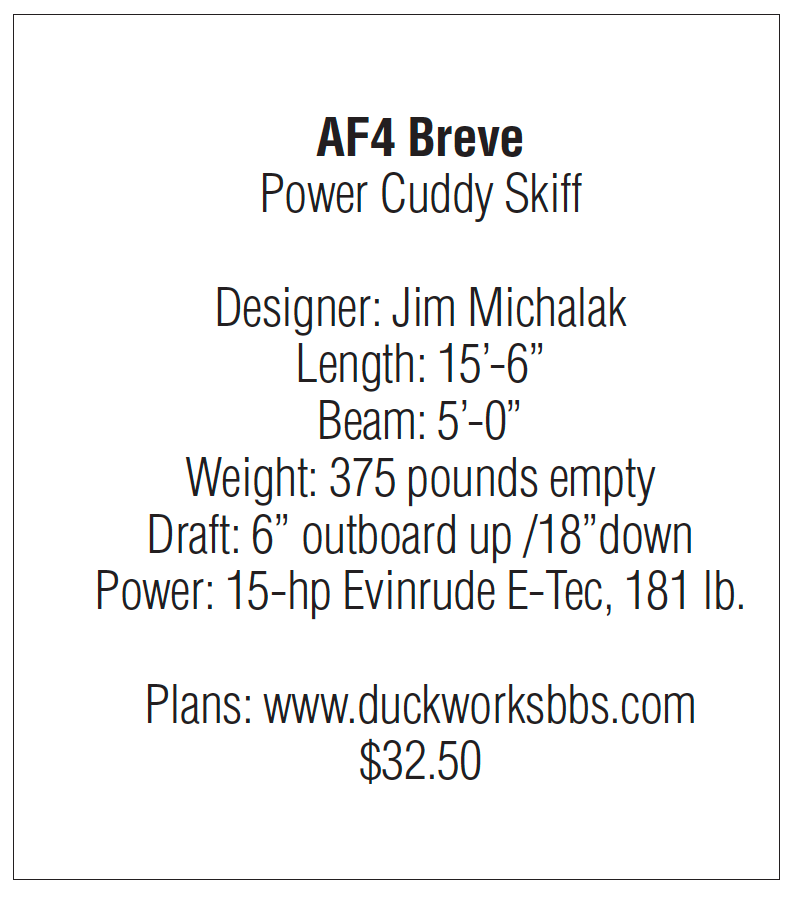Article by Robert Mueller
“The years thunder by. The dreams of youth grow dim where they lie caked in dust on the shelves of patience. Before we know it, the tomb is sealed….”—Sterling Hayden
Since the days of my youth I’ve been in love with boats. Large boats, small boats, motorboats, sailboats, tugboats, all kinds of boats. I knew I had to build one….someday.
As I neared retirement, I was startled to realize that my dreams of building a boat were in danger of being “caked in dust on the shelves of patience.” Time was awasting! I’d built a plywood canoe kit in the 1980s and had done repairs to an old Glen-L 13-foot catboat I’d once owned. Over the years I’d purchased many plans from a variety of boat designers—well done, but more complicated than I wanted for a first build. Some appeared to be years-long building projects, requiring a large work area and an even larger outlay of cash. I wanted a boat that could be built in the space of a single-car garage, not too expensive and possible to finish in less than six months. And it still had to look like a proper boat!
I had seen Duckworks Boat Builders Supply online. There, all in one place, was a long list of respected and noteworthy boat designers. All I had to do was pick a design. To build my first boat from a set of plans, it needed to be simple construction, with not too many sheets of plywood, straight-forward layout, basic joinery, the bottom and sides manageable by one person with a lot of clamps. And it had to have at least a smidgeon of good looks. After many enjoyable hours studying the multitude of plans available, I purchased the AF4 plans from Jim Michalak via Duckworks BBS, and discovered the 18-footer was too long to build in my 20-foot garage. So I then bought the AF4 Breve plans—at 15-1/2 feet the perfect size for my limited space.
As a boy, I messed about in flat-bottom skiffs on Penn Cove, Whidbey Island, and became aware of their tendency to be a little tender when boarding, and to pound when running into large waves. These characteristics did not seem too drastic, so I figured that with prudent seamanship and one eyeball on the weather, one could be quite safe and comfortable.
After carefully studying the AF4 Breve plans and reading the instruction booklet multiple times, I began by building an exact scale model at one inch to the foot, using the building sequence outlined in the plans. During the process, I decided to raise the foredeck of the actual boat by four inches…in part to give more headroom in the cuddy when using “Mr. Thetford.” The model really clarified that this idea would be practical and functional.
The design of the AF4 and AF4 Breve both show a “bird watcher” slot in the cabin. This style, of course, is reminiscent of some of Phil Bolger’s popular designs for small boats. Most folks usually cover the slot with some type of canvas. For the Pacific Northwest, I have my suspicions about such an arrangement (think rain, lots of rain), so it seemed sensible to fit removable plywood hatches over the slot. The plywood top was built in three nearly equal pieces. The forward panel hooks into a couple of metal studs at the forward end of the cuddy, and simply ties down. The middle panel and the aft panel are hinged so that the aft panel can swing open and lie flat over the middle panel, thus forming a companionway hatch for the cuddy. In practice my spouse Aleta and I have found this arrangement to be very useful. (At times, like anchoring or beaching, all three panels can be stowed, making it possible to walk almost the full length of the boat. At other times, the forward panel is stowed with middle panel held in place with bungees and the companionway panel flipped open. In this configuration the forward opening is great for picture taking or bird watching, while the companionway still gives quick access to the cuddy.)
For construction of the hull, I had some reservations about the building notes, which called for plywood from the local home-improvement store, Titebond III glue, and nails. I really wanted a solid build, so I used four sheets of 6mm (¼") marine grade Okoume plywood and four sheets of ½" marine grade Fir plywood. All hull-to-frame joints were epoxied and fastened with silicon-bronze screws. The plans also called for 1" x 2" pine for framing, wales, sheer and chine. Again, I felt compelled to upgrade to African mahogany for the wales, sheer, chine, stem and outboard motor mount.
The plans left glassing of the bottom as an option. Knowing what our Northwest beaches are like, this AF4 Breve got the full fiberglass and epoxy treatment. The hull is about 56" at its widest—just right for a single 60-inch wide by 14-foot long piece of fiberglass cloth.
It took about three months of evenings and weekends to build the basic boat. Another six weeks of part-time work installing the outboard, remote controls and other hardware. Total cost was just under $3,000 with the upgrades in materials. The 15-hp outboard and trailer were additional costs.
The AF4 Breve, which we named SKIDADL, will cruise happily at 4-6 knots all day. When we crank open the throttle we can do about 17 knots carrying all our gear for cruising. As expected, the boat will pound a bit at wide open throttle, however, taking the choppy water at a bit of an angle and throttling back a bit, it will behave nicely. The designer recommended an outboard up to 10 hp. The 15 hp two-stroke is more power than needed but came with remote control and power tilt. (The AF4 Breve would do very well with a smaller outboard in the 5-10hp range, if you are OK with a lower maximum speed. I have found the lower cruising speed to be very comfortable for the boat, and more importantly for the passengers.)
On the maiden voyage it became obvious that some type of shade was going to be necessary for the cockpit. The internet made it easy to find an off-the-shelf bimini to fit SKIDADL’s beam. The location of the mounting brackets on the boat was important, as I wanted to be able to use the bimini in three positions to create shade when fully open. The positions are tipped forward resting on the foredeck, vertical (normal position) or tipped aft over the outboard. This has worked great, giving us shade in all sun angles while moored.
This year’s Pocket Yacht Palooza, and ensuing three-day Palooza Crooza (see feature on page 20), was the first time we slept overnight on the boat. Using self-inflating mattresses, one person can sleep in the cabin, while the other person can sleep diagonally in the cockpit. I have installed hooks on the inside of the cuddy to hang gear, yet some items still get shoved to the sides when preparing to bunk down. I’m thinking that two small gear hammocks, port and starboard in the cuddy, will work better. Our 30-quart ice chest fits nicely at the forward end of the cuddy, and doubles as a step while anchoring or beaching the boat. I added a small shelf forward over the ice chest to store sleeping gear and clothes duffels by day, and food bags by night. One triple-duty item is the re-purposed dual battery box. With a plywood top added to the lid, it is a moveable cockpit seat, boarding step and galley box. Inside, it contains a single-burner butane stove, two pans, plates, bowls and cooking utensils. The stove sits on the plywood lid when in use, in the cockpit of course, for safety.
We’ve used SKIDADL mostly for day trips on our local Snohomish River, but plans are in the works to explore Baker Lake, Lake Chelan, more of South Puget Sound and Harrison Lake, British Columbia. The boat is basically a big skiff, so it has a trailer with bunks and is easily launched and retrieved nearly anywhere. We’ve really enjoyed our AF4 Breve, and look forward to many more adventures!•SCA•
First appeared in issue # 114







Loved the write up! I'm always intrigued at the performance of the "simpler" boats like Michalak, Bolger, etc tend to design so thank you for sharing
Excellent article and neat boat. Nice ideas on fitting out the cuddy and interior. Tks